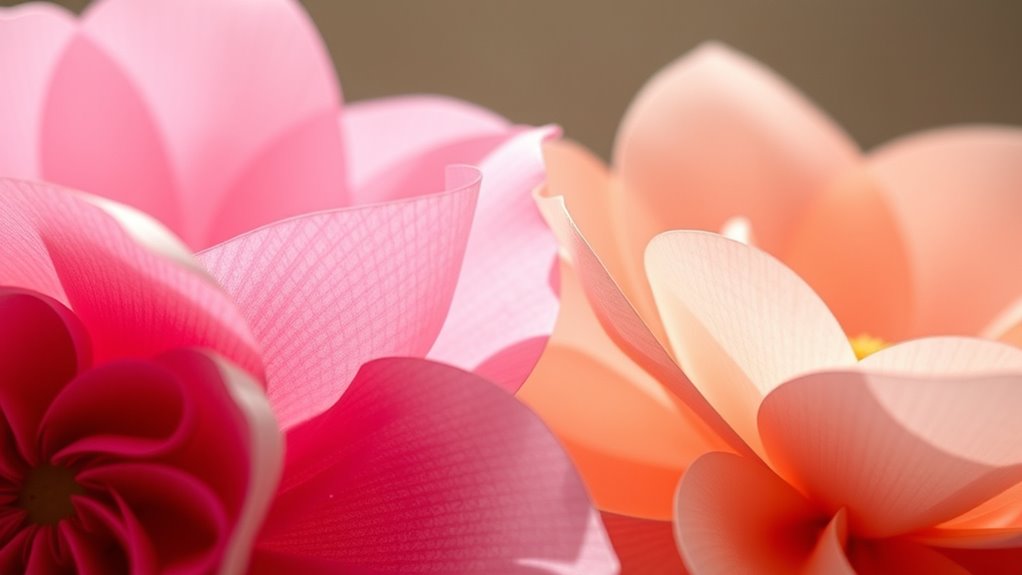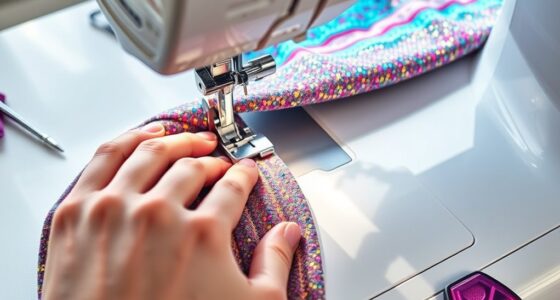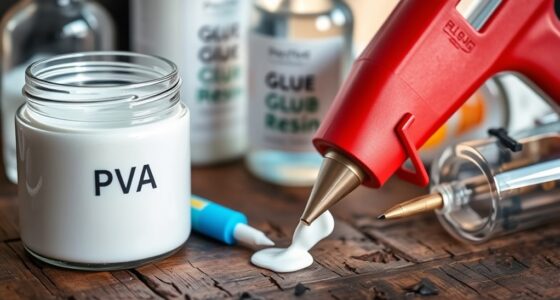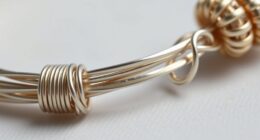To master paper flower techniques, focus on shaping, curling, and wiring your petals to create realistic blooms. Gently curl petal edges with a stylus or pencil to add texture, experimenting with tight rolls or loose waves for variety. Use thin wires to bend and support structures, then cover with floral tape for a polished look. Combining these methods brings depth and lifelike details, and if you continue exploring, you’ll discover even more tips to perfect your craft.
Key Takeaways
- Gently curl petal edges with stylus or fingers to create realistic, varied flower shapes.
- Use different curling techniques—tight, loose, or slight bends—to mimic diverse petal textures.
- Attach floral wire to petal bases for flexible shaping and to form stems or dynamic petal movements.
- Cover wired areas with floral tape to preserve texture and add color continuity.
- Combine shaping, curling, and wiring techniques to craft lifelike, durable paper flowers with depth and realism.
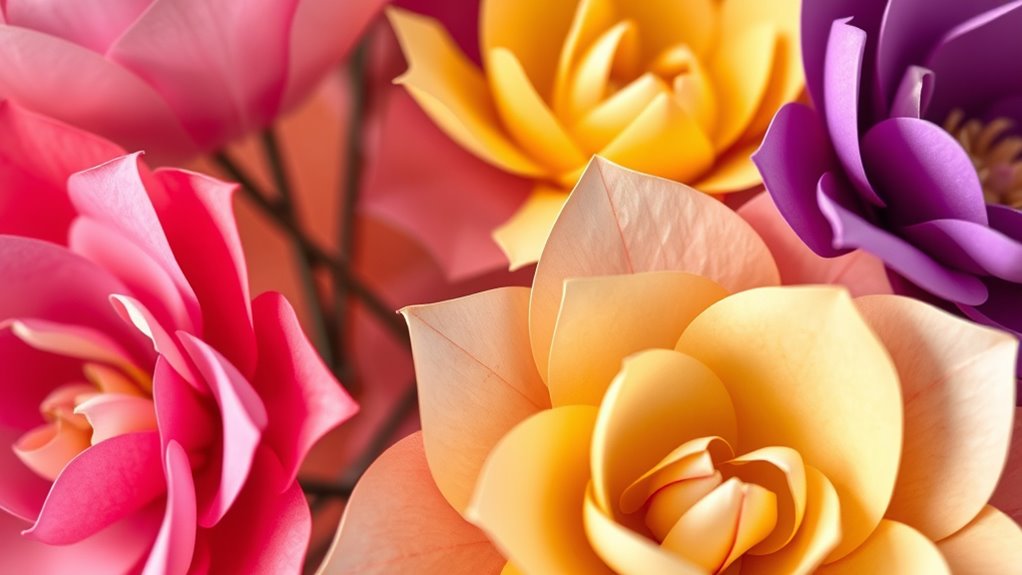
Creating beautiful paper flowers can be both rewarding and fun, whether you’re a beginner or an experienced crafter. One of the key aspects that elevates your paper flowers is understanding how to shape, curl, and wire the petals effectively. When working with flower petal textures, you want to pay close attention to how you manipulate the paper to mimic the natural variations found in real blooms. For instance, gently curling the edges of your petals with a pencil or a stylus creates a softer, more lifelike appearance. This technique helps add depth and dimension, making your flowers appear more dynamic and realistic. Additionally, experimenting with different techniques for curling—tight rolls, loose waves, or slight bends—allows you to replicate a wide range of flower types and petal styles.
Gently curl petal edges with a stylus to add depth and realism to your paper flowers.
Floral color blending is another essential element in crafting convincing paper flowers. When shaping petals, consider how colors blend seamlessly from one shade to another. You can achieve this by layering different shades of paper or by lightly airbrushing or blending colors onto the petals. This subtle gradation enhances the petal textures, giving them a more natural, multi-dimensional look. When manipulating the petals, you might use your fingers or tools to gently stretch and shape the paper, encouraging the colors to flow smoothly and creating a harmonious progression across the petal surface. Such attention to color blending works hand in hand with the petal textures, ensuring that the final flower looks vibrant and true to life.
Wiring is another critical step that allows you to give your flowers more control and realism. By attaching thin floral wires to the base of each petal or group of petals, you enable yourself to bend, shape, and position the flowers precisely. This technique gives you the flexibility to make the petals curl outward, bend inward, or create natural-looking stems. When wiring, be careful to wrap the wire securely around the petal base and cover any exposed wire with floral tape. This not only secures the shape but also preserves the delicate textures and colors you’ve crafted. The combination of well-shaped petals, thoughtfully blended colors, and sturdy wiring results in a finished paper flower that’s both visually stunning and structurally sound.
Mastering these techniques—shaping, curling, and wiring—empowers you to craft paper flowers that are vibrant, textured, and full of life. By focusing on petal textures and floral color blending, you bring depth and realism to your creations, making each flower distinctively beautiful and expressive.
Frequently Asked Questions
What Types of Paper Are Best for Flower Crafting?
The best paper for flowers depends on your project, but generally, you should choose lightweight yet sturdy options. Types of paper like crepe paper, tissue paper, and craft foam work well for flower crafting because they’re easy to shape and hold details. Crepe paper is especially popular for realistic petals, while tissue paper adds a delicate touch. Avoid heavy card stock, which can be hard to manipulate for detailed flower designs.
How Long Do Paper Flowers Typically Last?
Imagine a delicate paper blossom blooming in your hands—how long it lasts depends on your care. Typically, paper flowers can stay beautiful for months or even years with proper preservation methods. You can extend their flower longevity by avoiding direct sunlight, moisture, and handling too much. Using sealants or sprays helps lock in their vibrant colors, ensuring your crafted blooms remain stunning and fresh-looking for a long time.
Can These Techniques Be Used for Outdoor Decorations?
Yes, you can use these techniques for outdoor decorations if you prioritize weather resistance and UV protection. To guarantee your paper flowers withstand the elements, apply waterproof sealants and UV-resistant coatings. You might also consider using outdoor-specific paper or materials. By doing so, your flowers stay vibrant and intact longer, even in sunlight and rain, making them a beautiful addition to your outdoor decor.
What Tools Are Essential for Shaping Paper Flowers?
To shape paper flowers effectively, you need essential tools like floral scissors and shaping tools. These help you manipulate flower petal textures, giving them a realistic look. Additionally, selecting the right wire gauge is vital for curling and wiring petals and stems without tearing the paper. A fine wire gauge offers flexibility for delicate details, while a thicker gauge provides sturdy support for larger blooms, ensuring your paper flowers hold their shape beautifully.
Are There Eco-Friendly Options for Paper Flower Materials?
Imagine making beautiful blooms while caring for the planet—you can with eco-friendly options. You’ll find delightful recycled paper options and biodegradable flower materials that are perfect for sustainable crafting. These eco-conscious choices allow you to create stunning paper flowers without harming the environment. Embrace these greener alternatives, and enjoy crafting with materials that are both beautiful and kind to our world, making your floral art truly meaningful and eco-friendly.
Conclusion
As you master shaping, curling, and wiring, you’ll find your paper flowers come alive with a natural charm. It’s funny how, just when you think you’ve nailed one technique, a new idea sparks your creativity—like a coincidence guiding your hands. Keep experimenting, and you’ll discover that these techniques not only transform paper but also reveal a surprising connection between your patience and artistry. Before long, your blooms will feel as real as the world around you.
